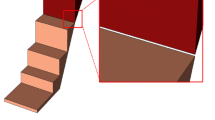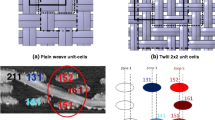Abstract
An automatic unstructured mesh generation approach is presented to discretize complex electronic packaging systems for finite element analysis. Various novel schemes are developed to resolve the common issues (models contain geometrical defects, models contain small but necessary features, simulation properties are predefined on models, etc.) to automate the entire mesh generation pipeline. These schemes include employing Boolean operations with a few technical considerations to resolve the geometrical defects of the original model, defining a sizing function that can adapt to small features, and develo** a new data structure named the unified topology model to connect a CAD model and the mesh resulting from the model. The proposed approach can generate quality meshes on certain models with geometrical defects, while state-of-the-art open-source tools (Netgen and Gmsh) generate nonconforming meshes on those models. Tests on complex configurations show that the proposed approach can achieve a speed-up of 3–5 times in comparison with state-of-the-art commercial tools (e.g., COMSOL Multiphysics). Simulation results are provided to demonstrate that the proposed approach can create a mesh with satisfactory quality.























Similar content being viewed by others
References
** J (2015) The finite element method in electromagnetics, 17–36
Ismail F, Sarker P, Mohamed M, Kim K, Ravaioli U (2018) Moving mesh adaptation for si and gan-based power device simulation. J Comput Electron 17(4):1621–1629
Zuo S, Zhang Y, Doñoro DG, Zhao X, Liu Q (2019) A novel finite element mesh truncation technology accelerated by parallel multilevel fast multipole algorithm and its applications. Appl Comput Electromagn Soc J (ACES) 2:1671–1678
Li C, Pan Z, Di M, Zhang F, Li Z, Jiang N, Wang A (2020) Esd device layout design guidelines by 3d tcad simulation. In: 2020 4th IEEE Electron Devices Technology & Manufacturing Conference (EDTM), pp. 1–4 . IEEE
Liu QQ, Zhuang M, Zhan W, Liu N, Liu QH (2022) An efficient thin layer equivalent technique of setd method for thermo-mechanical multi-physics analysis of electronic devices. Int J Heat Mass Transf 192:122816
Li B, Tang M, Yue H, Tang Y, Mao J (2019) Efficient transient thermal simulation of ics and packages with laguerre-based finite-element method. IEEE Trans Components Packag Manuf Technol 10(2):203–211
Li J, Tang M, Mao J (2021) Efficient transient thermal simulation with laguerre-based finite-element method and domain decomposition. Numer Heat Transf Part B: Fundam 80(1–2):14–28
Wang Y, Lu C, Li J, Tan X, Tse Y (2005) Simulation of drop/impact reliability for electronic devices. Finite Elem Anal Des 41(6):667–680
Ho-Le K (1988) Finite element mesh generation methods: a review and classification. Comput Aided Des 20(1):27–38
Berzins M (1999) Mesh quality: a function of geometry, error estimates or both? Eng Comput 15(3):236–247
Shewchuk J (2002) What is a good linear finite element? interpolation, conditioning, anisotropy, and quality measures (preprint). University of California at Berkeley 2002
Guo J, Ding F, Jia X, Yan D-M (2019) Automatic and high-quality surface mesh generation for cad models. Comput Aided Des 109:49–59
Bawin A, Henrotte F, Remacle J-F (2021) Automatic feature-preserving size field for three-dimensional mesh generation. Int J Numer Meth Eng 122(18):4825–4847
Slotnick JP, Khodadoust A, Alonso J, Darmofal D, Gropp W, Lurie E, Mavriplis DJ (2014) Cfd vision 2030 study: a path to revolutionary computational aerosciences. Technical report
Bowyer A (1981) Computing dirichlet tessellations. Comput J 24(2):162–166
Watson DF (1981) Computing the n-dimensional delaunay tessellation with application to voronoi polytopes. Comput J 24(2):167–172
Shewchuk JR (1998) Tetrahedral mesh generation by delaunay refinement. In: Proceedings of the Fourteenth Annual Symposium on Computational Geometry, pp. 86–95
Chen J, Zhao D, Huang Z, Zheng Y, Gao S (2011) Three-dimensional constrained boundary recovery with an enhanced steiner point suppression procedure. Comput struct 89(5–6):455–466
Chen J, Zhao D, Huang Z, Zheng Y, Wang D (2012) Improvements in the reliability and element quality of parallel tetrahedral mesh generation. Int J Numer Meth Eng 92(8):671–693
Shewchuk JR, Si H (2014) Higher-quality tetrahedral mesh generation for domains with small angles by constrained delaunay refinement. In: Proceedings of the Thirtieth Annual Symposium on Computational Geometry. SOCG’14, pp. 290–299. Association for Computing Machinery, New York, NY, USA. https://doi.org/10.1145/2582112.2582138
Si H (2015) Tetgen, a delaunay-based quality tetrahedral mesh generator. ACM Trans Math Softw 41(2):2–2. https://doi.org/10.1145/2629697
Chen J, Zheng J, Zheng Y, Si H, Hassan O, Morgan K (2017) Improved boundary constrained tetrahedral mesh generation by shell transformation. Appl Math Model 51:764–790
Chen J, Zheng J, Zheng Y, **ao Z, Si H, Yao Y (2017) Tetrahedral mesh improvement by shell transformation. Eng Comput 33(3):393–414
Lo S (1985) A new mesh generation scheme for arbitrary planar domains. Int J Numer Meth Eng 21(8):1403–1426
Löhner R, Parikh P (1988) Generation of three-dimensional unstructured grids by the advancing-front method. Int J Numer Meth Fluids 8(10):1135–1149
Nakahashi K, Sharov D (1995) Direct surface triangulation using the advancing front method. In: 12th Computational Fluid Dynamics Conference, p. 1686
Lan T, Lo S (1996) Finite element mesh generation over analytical curved surfaces. Comput Struct 59(2):301–309
Schöberl J (1997) Netgen an advancing front 2d/3d-mesh generator based on abstract rules. Comput Vis Sci 1(1):41–52
Thompson JF, Soni BK, Weatherill NP (1998) Handbook of grid generation, 524–543
Tremel U, Deister F, Hassan O, Weatherill NP (2004) Automatic unstructured surface mesh generation for complex configurations. Int J Numer Meth Fluids 45(4):341–364
Zhao D, Chen J, Zheng Y, Huang Z, Zheng J (2015) Fine-grained parallel algorithm for unstructured surface mesh generation. Comput Struct 154:177–191
Yu K, Chen J, Fu K, He J, Zheng J, Zheng Y (2022) On the efficiency of the advancing-front surface mesh generation algorithm. Comput-Aided Des 2:103403
Hu Y, Zhou Q, Gao X, Jacobson A, Zorin D, Panozzo D (2018) Tetrahedral meshing in the wild. ACM Trans Graph 37(4):60–1
Hu Y, Schneider T, Wang B, Zorin D, Panozzo D (2020) Fast tetrahedral meshing in the wild. ACM Trans Gr (TOG) 39(4):117–121
Zheng P, Yang Y, Liu Z, Xu Q, Wang J, Leng J, Liu T, Zhu Z, Chen J (2020) Parallel and automatic isotropic tetrahedral mesh generation of misaligned assemblies. CCF Trans High Perform Comput 2(2):149–163
Liu Z, Chen J, **a Y, Zheng Y (2021) Automatic sizing functions for unstructured mesh generation revisited. Eng Comput 38:3995–4023. https://doi.org/10.1108/EC-12-2020-0700
Chen J, **ao Z, Zheng Y, Zou J, Zhao D, Yao Y (2018) Scalable generation of large-scale unstructured meshes by a novel domain decomposition approach. Adv Eng Softw 121:131–146
Marot C, Pellerin J, Remacle J-F (2019) One machine, one minute, three billion tetrahedra. Int J Numer Meth Eng 117(9):967–990
Yu F, Zeng Y, Guan Z, Lo S (2020) A robust delaunay-aft based parallel method for the generation of large-scale fully constrained meshes. Comput Struct 228:106170
Geuzaine C, Remacle J-F (2009) Gmsh: A 3-d finite element mesh generator with built-in pre-and post-processing facilities. Int J Numer Meth Eng 79(11):1309–1331
Fabri A, Pion S (2009) Cgal: The computational geometry algorithms library. In: Proceedings of the 17th ACM SIGSPATIAL International Conference on Advances in Geographic Information Systems, pp. 538–539
COMSOL I (2021) COMSOL Multiphysics 5.6. https://cn.comsol.com/
S.A.S., O.C. (2021) Open CASCADE Technology. https://www.opencascade.com/open-cascade-technology/. Accessed
**ao Z, Chen J, Zheng Y, Zeng L, Zheng J (2014) Automatic unstructured element-sizing specification algorithm for surface mesh generation. Proc Eng 82:240–252. https://doi.org/10.1016/j.proeng.2014.10.387
Chen J, **ao Z, Zheng Y, Zheng J, Li C, Liang K (2017) Automatic sizing functions for unstructured surface mesh generation. Int J Numer Meth Eng 109(4):577–608
Mäntylä M (1987) An introduction to solid modeling, 1–101
Stroud I (2006) Boundary representation modelling techniques, 1–787
Tautges TJ (2001) Cgm: A geometry interface for mesh generation, analysis and other applications. Eng Comput 17(3):299–314
Cuillière J-C, Francois V (2014) Integration of cad, fea and topology optimization through a unified topological model. Computer-Aided Des Appl 11(5):493–508
Beall MW, Shephard MS (1997) A general topology-based mesh data structure. Int J Numer Meth Eng 40(9):1573–1596
Pirzadeh SZ (2010) Advanced unstructured grid generation for complex aerodynamic applications. AIAA J 48(5):904–915
Quadros WR, Vyas V, Brewer M, Owen SJ, Shimada K (2010) A computational framework for automating generation of sizing function in assembly meshing via disconnected skeletons. Eng Comput 26(3):231–247
Alexandre Cunha SS, Canann Scott (1997) Automatic boundary sizing for 2d and 3d meshes. AMD Trends Unstruct Mesh Gen, ASME 220:65–72
**e L, Chen J, Liang Y, Zheng Y (2012) Geometry-based adaptive mesh generation for continuous and discrete parametric surfaces. J Inf Comput Sci 9(8):2327–2344
Dapogny C, Dobrzynski C, Frey P (2014) Three-dimensional adaptive domain remeshing, implicit domain meshing, and applications to free and moving boundary problems. J Comput Phys 262:358–378
Bartoň M, Hanniel I, Elber G, Kim M-S (2010) Precise hausdorff distance computation between polygonal meshes. Computer Aided Geometric Design 27(8):580–591
Borouchaki H, Hecht F, Frey PJ (1998) Mesh gradation control. Int J Numer Meth Eng 43(6):1143–1165
Pippa S, Caligiana G (2005) Gradh-correction: guaranteed sizing gradation in multi-patch parametric surface meshing. Int J Numer Meth Eng 62(4):495–515
Wald I, Boulos S, Shirley P (2007) Ray tracing deformable scenes using dynamic bounding volume hierarchies. ACM Trans Gr (TOG) 26(1):6
Eberly D (1999) Distance between point and triangle in 3d. Magic Software, http://www.magic-software.com/Documentation/pt3tri3.pdf
Aubry R, Karamete BK, Mestreau EL, Dey S (2014) A three-dimensional parametric mesher with surface boundary-layer capability. J Comput Phys 270:161–181
ANSYS I (2021) Ansys Electronics 2021 R1. https://www.ansys.com/products/electronics
Pébay P, Baker T (2003) Analysis of triangle quality measures. Math Comput 72(244):1817–1839
Parthasarathy V, Graichen C, Hathaway A (1994) A comparison of tetrahedron quality measures. Finite Elem Anal Des 15(3):255–261
Knupp PM (2000) Achieving finite element mesh quality via optimization of the jacobian matrix norm and associated quantities. part ii–a framework for volume mesh optimization and the condition number of the jacobian matrix. Int J Numer Meth Eng 48(8):1165–1185
Knupp PM (2003) Algebraic mesh quality metrics for unstructured initial meshes. Finite Elem Anal Des 39(3):217–241
Cadence Design Systems I (2021) Equiangle Skewness. https://www.pointwise.com/doc/user-manual/examine/functions/equiangle-skewness.html
Acknowledgements
The authors would like to thank the support Zhejiang Provincial Science and Technology Program in China (Grant No.2021C01108) and the Innovative Research Foundation of Ship General Performance in China (Grant No.14022105).
Author information
Authors and Affiliations
Corresponding author
Ethics declarations
Competing interests
The authors declare that they have no known competing financial interests or personal relationships that could have appeared to influence the work reported in this paper.
Additional information
Publisher's Note
Springer Nature remains neutral with regard to jurisdictional claims in published maps and institutional affiliations.
Rights and permissions
Springer Nature or its licensor (e.g. a society or other partner) holds exclusive rights to this article under a publishing agreement with the author(s) or other rightsholder(s); author self-archiving of the accepted manuscript version of this article is solely governed by the terms of such publishing agreement and applicable law.
About this article
Cite this article
Fu, K., Chen, J., Li, J. et al. Automatic unstructured mesh generation approach for simulation of electronic packaging system. Engineering with Computers 39, 3527–3559 (2023). https://doi.org/10.1007/s00366-022-01764-w
Received:
Accepted:
Published:
Issue Date:
DOI: https://doi.org/10.1007/s00366-022-01764-w




